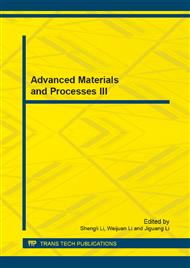p.251
p.259
p.262
p.266
p.273
p.279
p.284
p.289
p.293
Effect of Cooling Rate on Oxidation Behaviour of Microalloyed Steel
Abstract:
Oxidation characteristics of a microalloyed low carbon steel were investigated by a hot rolling mill combined with acceleration cooling system over the cooling rate range from 20 to 70°C/s. The effects of cooling rate after hot rolling on microstructure and phase composition of oxide scale were examined. The results showed that the increase of the cooling rate has a significant influence on the decrease of the grain size and surface roughness of oxide scale. A higher cooling rate promotes the formation of retain wustite and primary magnetite precipitation while suppression of eutectoid α-iron precipitates. This provides the possibility to enhance potential contribution of magnetite precipitates with preferable ductility, and hence fabricates a desired oxide-scale structure under continuous post cooling conditions considering a suitable cooling rate.
Info:
Periodical:
Pages:
273-278
Citation:
Online since:
September 2013
Authors:
Price:
Сopyright:
© 2013 Trans Tech Publications Ltd. All Rights Reserved
Share:
Citation:


